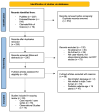Scoping Review-The Effectiveness of Clear Aligners in the Management of Anterior Open Bite in Adult Patients
- PMID: 40572801
- PMCID: PMC12195066
- DOI: 10.3390/medicina61061113
Scoping Review-The Effectiveness of Clear Aligners in the Management of Anterior Open Bite in Adult Patients
Abstract
Background and Objectives: Anterior open-bite malocclusion remains a challenging orthodontic condition where achieving a positive overbite necessitates precise control of incisor extrusion and molar intrusion. With recent advances in clear aligner therapy-improved materials, attachment techniques and digital treatment planning-the potential for non-invasive treatment has increased. This scoping review systematically maps the evidence on the efficacy of clear aligners in treating anterior open bite among adult patients, outlines treatment protocols and highlights gaps in the literature. Materials and Methods: A systematic search was conducted in PubMed/Medline, Embase/ScienceDirect and Clarivate/Web of Science for literature published in English between January 2000 and December 2024. Studies involving adult patients treated with clear aligners (predominantly Invisalign®) were included. A two-step screening process was applied, and data were charted according to pre-specified criteria. The review adheres to the PRISMA-ScR checklist guidelines. Results: From an initial pool of 802 articles, 30 met the inclusion criteria following duplicate removal and full-text screening. The evidence suggests that clear aligners can achieve measurable incisor extrusion and posterior intrusion when appropriate auxiliary techniques (e.g., attachments and mini screws) are used. However, digital treatment planning software may overestimate movement predictions, necessitating iterative refinement phases. Patient compliance, clinician expertise and technological limitations are key factors influencing outcomes. Conclusions: Clear aligner therapy represents a promising alternative to fixed appliances for anterior open-bite correction in adults, although challenges remain in achieving precise vertical control. Further high-quality randomized controlled trials and standardized outcome measures are needed to confirm long-term stability and efficacy.
Keywords: Invisalign®; anterior extrusion; anterior open bite; apertognathia; clear aligner; malocclusion; nonocclusion; posterior intrusion.
Conflict of interest statement
The authors declare no conflicts of interest.
Figures
Similar articles
-
Skeletal and dental open bite treatment using clear aligners and orthodontic miniscrew-anchored fixed appliances in permanent dentition: A systematic review.J World Fed Orthod. 2025 Feb;14(1):46-63. doi: 10.1016/j.ejwf.2024.09.003. Epub 2024 Oct 22. J World Fed Orthod. 2025. PMID: 39443221
-
The effects of anterior spaces on the intrusion of mandibular incisors with clear aligners in extraction cases: a finite-element analysis.BMC Oral Health. 2025 Jul 4;25(1):1097. doi: 10.1186/s12903-025-06222-9. BMC Oral Health. 2025. PMID: 40615830 Free PMC article.
-
Efficacy of Clear Aligner Therapy for the Treatment of Anterior Open Bite in Adults: A Systematic Review and Meta-Analysis.Orthod Craniofac Res. 2025 Apr;28(2):261-270. doi: 10.1111/ocr.12868. Epub 2024 Oct 24. Orthod Craniofac Res. 2025. PMID: 39445659
-
Non-surgical adjunctive interventions for accelerating tooth movement in patients undergoing orthodontic treatment.Cochrane Database Syst Rev. 2023 Jun 20;6(6):CD010887. doi: 10.1002/14651858.CD010887.pub3. Cochrane Database Syst Rev. 2023. PMID: 37339352 Free PMC article.
-
Assessment of the efficacy of various maxillary molar intrusion therapies: a systematic review.Prog Orthod. 2023 Nov 13;24(1):37. doi: 10.1186/s40510-023-00490-3. Prog Orthod. 2023. PMID: 37953383 Free PMC article.
References
-
- Moya S.P., Zafra J.L. Vertical problems. In: Moya S.P., Zafra J.L., editors. Aligner Techniques in Orthodontics. Wiley-Blackwell; Hoboken, NJ, USA: 2021. pp. 355–422. - DOI
Publication types
MeSH terms
LinkOut - more resources
Full Text Sources
Miscellaneous



